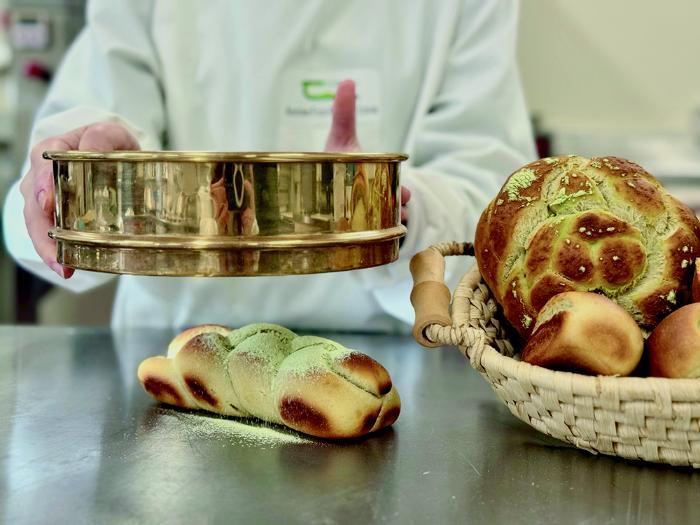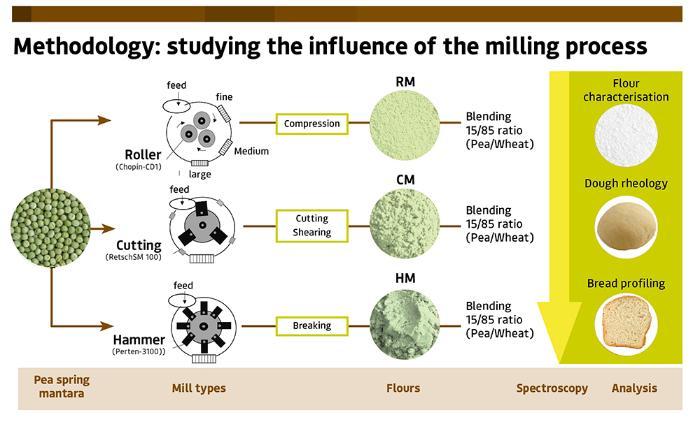20 February 2025
Peas of mind
Innovative research at Teagasc Ashtown’s Food Quality and Sensory Science department is examining how Irish-grown peas can help promote new, sustainable food solutions.

Using Irish-grown peas as a bread ingredient may improve product quality, while also providing economic and sustainability boosts. Credit: Teagasc
Increasing consumer demand for high-protein, plant-based foods has sparked innovation in the bakery sector, driven by health and sustainability trends. Incorporating alternative plant sources has been shown to enhance the nutritional profile of baked products. However, it is also crucial for any new foods to balance nutritional benefits with consumer acceptability.
Peas are an excellent source of protein, fibre and micronutrients. A research team from Teagasc Ashtown is exploring new, food-focused applications of Irish-grown peas to formulate bread products that are technologically optimised and health-enhanced. By using locally grown produce, this innovative work holds potential benefits for the environment, local economy and consumer health.
From field to flour
Research began by evaluating the pea milling process, explains Mariana Maçãs, a Walsh Scholar at Teagasc Ashtown.
“The milling process is a critical step in pea flour production, influencing the quality of both the resulting flour and the final product. We evaluated three milling processes – roller, hammer and cutting – each of which produced unique flour characteristics.”
- The hammer mill produced flour with a high content of fibre and protein, and achieved a flour yield of 93.9%.
- The roller mill delivered flour with a higher starch content and lower content of insoluble dietary fibre. These differences in composition are due to the fractionation system of the roller miller. The larger milling fraction was discarded, resulting in a yield of 55.64%.
- The cutting mill created flour with a similar composition to that of hammer-milled flour. However, this flour had a higher proportion of damaged starch, as well as the lowest yield at 39.15%.
In addition to traditional analytical methods, near-infrared (NIR) spectroscopy was used to evaluate flour quality at the compositional and structural level. NIR is a rapid and non-destructive technique used to analyse the properties of materials such as flour and bread, by using near-infrared light on a sample and measuring how the light interacts with it. This interaction provides information about the sample’s composition, including protein, moisture and fibre.
“NIR obtains a ‘fingerprint’ of the material, allowing for analysis without destroying the sample,” Mariana explains. “In this study, NIR spectroscopy provided results that aligned with the proximate composition analysis. It also proved an effective tool for distinguishing between different flour types and identifying the milling techniques used for peas.”
Hammer-milling was found to be the most suitable process for milling peas for onward bread applications as this flour showed the highest yield, fibre and protein content. Further research was then undertaken to study the influence of the pea milling process on bread-making performance, crumb texture, microstructure and shelf-life.

Finding the balance
Milled Irish pea flour was blended with wheat flour at a 15:85 pea to wheat ratio, and the resulting dough rheology, bread crumb texture, crumb microstructure and nutritional aspects were studied, showing promising results, Mariana notes.
“Incorporating pea flour improved the nutritional profile of bread, particularly its protein and fibre content. The hammer- milling process produced flour with the most favourable quality markers for bread production, including volume and texture, with these breads also showing the slowest rate of crumb staling.”
NIR spectroscopy effectively differentiated between wheat and non-wheat formulations, identified storage time across breads, and predicted flour quality, highlighting again its potential for rapid, non-destructive analysis.
However, there are some points of caution, Mariana adds.
“Incorporating low levels of pea flour into bread formulations was shown to yield a product with good baking characteristics and slightly elevated nutritional properties. Increasing the incorporation levels to further boost the nutrition will likely compromise the flavour characteristics – due to indigenous bitter compounds in peas – and lead to undesirable physical properties.”
Trust the process
Research has continued and has most recently focused on non-thermal and thermal processing technologies for the hammer-milled pea flours – exploring the possibility of including higher levels of pea flour without compromising the end product, while at the same time enhancing its nutritional profile.
Hammer-milled pea flours were processed by roasting, microwave and ultrasound treatments, individually and in combination. Roasting can enhance overall bread quality by improving the development of volatile compounds that contribute to a richer flavour and aroma profile. Emerging techniques such as microwave and ultrasound offer innovative approaches with the potential to improve processing efficiency, Mariana says.
“These methods have enabled us to include up to 35% pea flour in bread formulations as a substitution for wheat flour. Initial results demonstrate that these treatments positively impact the structure and sensory properties of the resulting breads. Specifically, the treated flours improved loaf-specific volume, reduced crumb hardness, and slowed the crumb staling kinetics. Preliminary studies also show positive effects on taste and aroma.”
Bridging the gap
A significant aspect of the research involves evaluating the digestion characteristics of pea-enriched bread using dynamic in vitro models that closely simulate human digestion. This innovative approach assesses factors such as starch and protein hydrolysis during digestion, providing valuable insights into the physiological benefits of incorporating pea flour, notes Mariana.
“When comparing wheat bread to pea-enriched bread, we observed a lower glycemic index for the latter. These initial results are very promising, as they demonstrate the ability to improve the acceptability of bread while simultaneously enhancing its nutritional and digestive benefits.”
“The findings from the research team have broad implications for academia, the food and crops industries, and consumers,” Mariana concludes.
“By optimising milling techniques and applying innovative processing technologies, the potential of Irish-grown peas has been demonstrated as a viable step forward in sustainable food innovation, bridging the gap between health and acceptability.”
Funding
This work was funded by Teagasc under the Walsh Scholarship Programme. Project Acronym: HighPBreads. Project reference: 2021044.
Contributors
Mariana Maçãs, Walsh Scholar, Teagasc Food Quality & Sensory Science Department, Ashtown.
Eimear Gallagher, Principal Research Officer, Teagasc Food Quality & Sensory Science Department, Ashtown. eimear.gallagher@teagasc.ie
Barbara Biduski, Research Officer, Teagasc Food Quality & Sensory Science Department, Ashtown.
For a deeper dive into this innovative research, explore the full study here.
